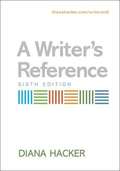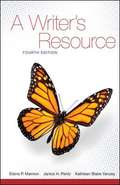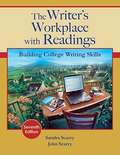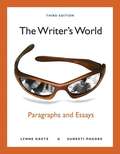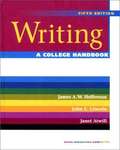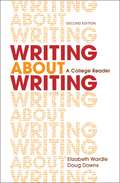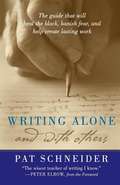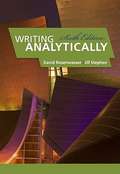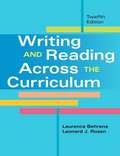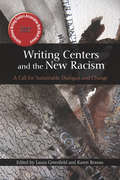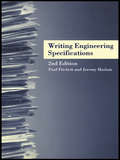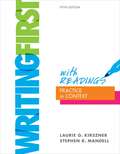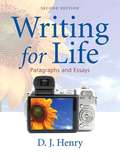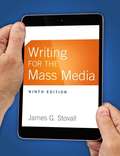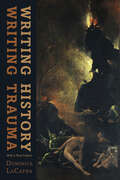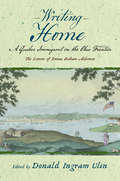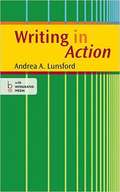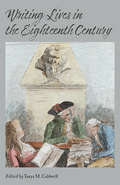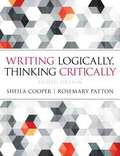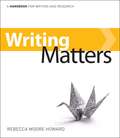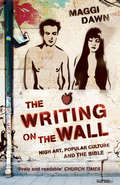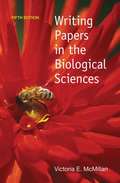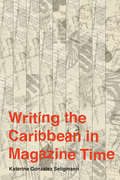- Table View
- List View
A Writer’s Reference (6th edition)
by Diana HackerA Writer's Reference is the most widely adopted college handbook ever published. The new edition is available in a classic version that provides more help with academic writing, serves a wider range of multilingual students, and lends more support for college research -- all in an easy-to-use quick-reference format. Now for all the ways you teach your course, you can choose the classic version or choose from among 4 additional versions with varied content. A Writer's Reference with Exercises is tailor-made for classroom use or for additional grammar practice with 86 integrated exercise sets. A Writer's Reference with Writing in the Disciplines provides help for college writing beyond composition with advice and models in six academic disciplines. A Writer's Reference with Writing about Literature includes an entire tabbed section on interpreting and writing about works of literature, with two annotated student essays. A Writer's Reference with Extra Help for ESL Writers includes an entire tabbed section for nonnative speakers of English; it offers targeted advice and strategies for college writing and research.
A Writer's Resource: A Handbook for Writing and Research (Fourth Edition)
by Elaine P. Maimon Janice H. Peritz Kathleen Blake YanceyA Writer's Resource focuses on the most common assignments and writing situations students will encounter in and beyond college, helping them to meet the challenges of composing in different genres and media.
The Writer's Workplace with Readings: Building College Writing Skills (7th Edition)
by Sandra Scarry John ScarryFor more than 20 years, THE WRITER'S WORKPLACE has served the needs of more than half a million two- and four-year students as they have worked their way toward rewarding careers in a variety of fields. Sandra Scarry and John Scarry present writing instruction in a clear and inviting form, with step-by-step explanations to help build and maintain students' confidence in their writing. The result of many years of classroom teaching and research, this comprehensive and time-tested resource reflects the authors' understanding that students are unique individuals, with diverse backgrounds and interests that must be accounted for as they engage in the writing process.
The Writer's World: Paragraphs and Essays (3rd Edition)
by Lynne Gaetz Suneeti PhadkeThe Writer's World series was written to address the diverse needs of today's students: students whose first language is not English, students who respond favorably to visuals, and students who have varying skill levels.
Writing: A College Handbook (5th edition)
by James A. W. Hefferman John E. Lincoln Janet AtwillThe Fifth Edition exemplifies in clear, engaging prose the skills that students need to communicate in a wide variety of rhetorical contexts. A reliable and easy-to-use reference tool and an up-to-date rhetoric and research guide, Writing: A College Handbook invites students to discover the power of effective writing.
Writing about Writing: A College Reader 2nd Edition
by Elizabeth Wardle Doug DownsLiteracies : where do your ideas about reading and writing come from? -- Individual in community : how do texts mediate activities? -- Rhetoric : how is meaning constructed in context? -- Processes : how are texts composed? -- Multimodal composition : what counts as writing?
Writing Alone and With Others
by Pat Schneider Peter ElbowFor more than a quarter of a century, Pat Schneider has helped writers find and liberate their true voices. She has taught all kinds--the award winning, the struggling, and those who have been silenced by poverty and hardship. Her innovative methods have worked in classrooms from elementary to graduate level, in jail cells and public housing projects, in convents and seminaries, in youth at-risk programs, and with groups of the terminally ill. Now, in Writing Alone and with Others, Schneider's acclaimed methods are available in a single, well-organized, and highly readable volume. The first part of the book guides the reader through the perils of the solitary writing life: fear, writer's block, and the bad habits of the internal critic. In the second section, Schneider describes the Amherst Writers and Artists workshop method, widely used across the U. S. and abroad. Chapters on fiction and poetry address matters of technique and point to further resources, while more than a hundred writing exercises offer specific ways to jumpstart the blocked and stretch the rut-stuck. Schneider's innovative teaching method will refresh the experienced writer and encourage the beginner. Her book is the essential owner's manual for the writer's voice.
Writing America: Language And Composition In Context AP* Edition
by David A. Jolliffe Hephzibah RoskellyWe have designed Writing America: Language and Composition in Context AP* Edition so that it can be used as the foundational text in a course that emphasizes reading, writing, and analyzing texts. Writing America teaches reading as a dynamic, interactive process. It teaches writing as a craft, related to reading, that produces rich, purposeful, well-planned and well-executed texts. It teaches the structure and organization of texts, at the level of both the whole text and the sentence. It couches this instruction in an examination of vitally important works of American literature, art, and culture, accompanied by a study of contemporary pieces that unpack current thinking on the issues and themes raised by the historical works.
Writing Analytically (6th Edition)
by David Rosenwasser Jill StephenRosenwasser and Stephen (Muhlenberg College, Allentown, PA) show undergraduate students in first-year writing courses, as well as those in more advanced writing-intensive courses in various subjects, how to learn to analyze information and use writing to discover and develop ideas. They explain how to become more observant and push observations to implications and conclusions; use evidence, evolve claims, and converse with sources to write analytical papers; and understand organization, disciplinary formats, introductions and conclusions, and grammar and style. Writing exercises that can be applied to print and visual, text-based, and experiential materials are included, as are tips from professors on differences in disciplines other than English, rhetoric, or composition. This edition has a new introductory chapter previewing key topics, more examples, and more lists and rationales. It has two toolkit chapters on analytical methods instead of one, some reorganization and reformatting, more description of discipline-specific writing (especially the natural and social sciences), and new material in chapters on form. It has new sections on Rogerian argument, practical reasoning, and figurative logic, and expanded treatment of the four documentation styles. It clarifies step-by-step instructions, uncovering assumptions, and the method of looking for patterns of repetition and contrast. Another edition of the book includes readings. Annotation ©2012 Book News, Inc. , Portland, OR (booknews. com)
Writing and Reading Across the Curriculum (Twelfth Edition)
by Laurence Behrens Leonard J. RosenRemaining one of the best-selling interdisciplinary composition texts for over twenty-five years, Writing and Reading Across the Curriculum helps readers learn to write effectively for college.
Writing Centers and the New Racism: A Call for Sustainable Dialogue and Change
by Greenfield, Laura; Rowan, KarenNoting a lack of sustained and productive dialogue about race in university writing center scholarship, the editors of this volume have created a rich resource for writing center tutors, administrators, and scholars. Motivated by a scholarly interest in race and whiteness studies, and by an ethical commitment to anti-racism work, contributors address a series of related questions: How does institutionalized racism in American education shape the culture of literacy and language education in the writing center? How does racism operate in the discourses of writing center scholarship/lore, and how may writing centers be unwittingly complicit in racist practices? How can they meaningfully operationalize anti-racist work? How do they persevere through the difficulty and messiness of negotiating race and racism in their daily practice? The conscientious, nuanced attention to race in this volume is meant to model what it means to be bold in engagement with these hard questions and to spur the kind of sustained, productive, multi-vocal, and challenging dialogue that, with a few significant exceptions, has been absent from the field.
Writing Engineering Specifications
by Paul Fitchett Jeremy HaslamEngineers need to understand the legal and commercial context in which they draw up technical specifications. This thoroughly up-dated edition of Haslam's successful Writing Engineering Specifications provides a concise guide to technical specifications and leads the reader through the process of writing these instructions, with clear advice to help the student and professional avoid legal disputes or the confusion and time wasting caused by poor drafting. Designers and project managers should find this invaluable, and it should be helpful to insurers, lawyers, estimators and the like.
Writing First With Readings: Practice In Context
by Laurie G. Kirszner Stephen R. MandellBest-selling authors and veteran college writing instructors Laurie Kirszner and Stephen Mandell believe that students learn to write best when they use their own writing as a starting point. In Writing First with Readings: Practice in Context, designed for the paragraph to essay course, Kirszner and Mandell take seriously the ideas and expressive abilities of developmental students, as well as their need to learn the rules of writing and grammar. Visual writing prompts that open every chapter get students writing immediately. By moving frequently between their own writing, writing models and instruction, and workbook-style mastery exercises, students get constant reinforcement of the skills they are learning. Thoughtful chapters on college success, research, and critical reading, along with high-interest essays, round out the text, making it the perfect introduction to college writing.
Writing For Life (Second Edition)
by D. J. HenryD. J. Henry wrote Writing for Life from the ground up for today's college student. The ground-breaking approach of combining instruction and visual tools makes writing, reading and thinking processes visible, and shows the processes rather than just telling students about them. Highly graphic layouts and unique visual pedagogy empower students to transfer the learning strategies they already use in interpreting the visual world to the task of writing.
Writing For The Mass Media (Ninth Edition)
by James G. StovallA clear and effective introduction to media writing Writing for the Mass Media offers clear writing, simple organization, abundant exercises, and precise examples that give students information about media writing and opportunities to develop their skills as professional writers. With a focus on a converged style of media writing, and converting that style into real work, this ninth edition maintains its classic and effective text/workbook format while staying ahead of the curve and preparing students for their future careers. MyCommunicationLab is an integral part of the Stovall program. MediaShare allows students to post speeches and share them with classmates and instructors. Interactive videos provide students with the opportunity to watch and evaluate sample speeches. Online self-assessments and pre- and post-tests help students assess their comfort level with public speaking and their knowledge of the material.
Writing from the Hill: An Introduction to Reading and Writing about Literature
by Kendra N. Bryant Veronica A. YonWriting from the Hill: An Introduction to Reading and Writing about Literature for Freshman Communicative Skills II, ENC 1102 and 1122 (Honors), Department of English & Modern Languages, Florida A&M University. A custom edition of: A Short Guide to Writing about Literature 12e by Sylvan Barnet and William E. Cain
Writing History, Writing Trauma (Parallax: Re-visions of Culture and Society)
by Dominick LaCapraAn updated edition of a major work in trauma studies.Trauma and its aftermath pose acute problems for historical representation and understanding. In Writing History, Writing Trauma, Dominick LaCapra critically analyzes attempts by theorists and literary critics to come to terms with trauma and with the crucial role post-traumatic testimonies—notably Holocaust testimonies—assume in thought and in writing. These attempts are addressed in a series of six interlocking essays that adapt psychoanalytic concepts to historical analysis, while employing sociocultural and political critique to elucidate trauma and its aftereffects in culture and in people. This updated edition includes a substantive new preface that reconsiders some of the issues raised in the book.
Writing Home: A Quaker Immigrant on the Ohio Frontier; the Letters of Emma Botham Alderson
by Emma AldersonWriting Home offers readers a firsthand account of the life of Emma Alderson, an otherwise unexceptional English immigrant on the Ohio frontier in mid-nineteenth-century America, who documented the five years preceding her death with astonishing detail and insight. Her convictions as a Quaker offer unique perspectives on racism, slavery, and abolition; the impending war with Mexico; presidential elections; various religious and utopian movements; and the practices of everyday life in a young country. Introductions and notes situate the letters in relation to their critical, biographical, literary, and historical contexts. Editor Donald Ulin discusses the relationship between Alderson’s letters and her sister Mary Howitt’s Our Cousins in Ohio (1849), a remarkable instance of transatlantic literary collaboration. Writing Home offers an unparalleled opportunity for studying immigrant correspondence due to Alderson’s unusually well-documented literary and religious affiliations. The notes and introductions provide background on nearly all the places, individuals, and events mentioned in the letters. Published by Bucknell University Press. Distributed worldwide by Rutgers University Press.
Writing In Action
by Andrea A. LunsfordAndrea Lunsford’s research treats student writers as writers first—not only in the classroom, but in every aspect of their lives. Her newest handbook features a simple and inviting design that helps students find solutions for every situation as they translate their skills as writers in their day-to-day lives to the conventions of solid academic writing. Featuring the writing process coverage of larger handbooks at a value price, Writing in Action is a supportive reference that emphasizes rhetorical strategies that help students put their ideas into action.
Writing Lives in the Eighteenth Century (Aperçus: Histories Texts Cultures)
by Lisa Berglund Marilyn Francus Peter Sabor James J. Caudle Victoria Warren Todd GilmanWriting Lives in the Eighteenth Century is a collection of essays on memoir, biography, and autobiography during a formative period for the genre. The essays revolve around recognized male and female figures—returning to the Boswell and Burney circle—but present arguments that dismantle traditional privileging of biographical modes. The contributors reconsider the processes of hero making in the beginning phases of a culture of celebrity. Employing the methodology William Godwin outlined for novelists of taking material “from all sources, experience, report, and the records of human affairs,” each contributor examines within the contexts of their time and historical traditions the anxieties and imperatives of the auto/biographer as she or he shapes material into a legacy. New work on Frances Burney D’Arblay’s son, Alexander, as revealed through letters; on Isabelle de Charriere; on Hester Thrale Piozzi; and on Alicia LeFanu and Frances Burney’s realignment of family biography extend current conversations about eighteenth century biography and autobiography. Published by Bucknell University Press. Distributed worldwide by Rutgers University Press.
Writing Logically, Thinking Critically
by Sheila Cooper Rosemary PattonThis concise, accessible text teaches students how to write logical, cohesive arguments and how to evaluate the arguments of others. Integrating writing skills with critical thinking skills, this practical book teaches students to draw logical inferences, identify premises and conclusions and use language precisely. Students also learn how to identify fallacies and to distinguish between inductive and deductive reasoning. Ideal for any composition class that emphasizes argument, this text includes coverage of writing style and rhetoric, logic, literature, research and documentation.
Writing Matters: A Handbook for Writing and Research
by Rebecca Moore HowardWriting Matters unites research, reasoning, documentation, grammar and style in a cohesive whole, helping students see the conventions of writing as a network of responsibilities writers have.
The Writing on the Wall: High Art, Popular Culture and the Bible
by Maggi DawnIn an increasingly secularised society, the average person is unlikely to have a working knowledge of the Bible. Yet a great deal of our culture is built on stories or ideas that come from the Bible. Literature, art, music, language and even the fabric of our society - such as our justice system - is built on Christian concepts and biblical references. THE WRITING ON THE WALL provides a fascinating introduction to the Bible's best-known, and most influential, stories.
Writing Papers in the Biological Sciences (Fifth Edition)
by Victoria E. McmillanWritten by a professional biologist who is also an experienced writing teacher, this comprehensive guide for students writing in biology, zoology, and botany provides detailed instruction on researching, drafting, revising, and documenting papers, reviews, poster presentations, and other forms of writing.
Writing the Caribbean in Magazine Time (Critical Caribbean Studies)
by Katerina Gonzalez SeligmannWriting the Caribbean in Magazine Time examines literary magazines generated during the 1940s that catapulted Caribbean literature into greater international circulation and contributed significantly to social, political, and aesthetic frameworks for decolonization, including Pan-Caribbean discourse. This book demonstrates the material, political, and aesthetic dimensions of Pan-Caribbean literary discourse in magazine texts by Suzanne and Aimé Césaire, Nicolás Guillén, José Lezama Lima, Alejo Carpentier, George Lamming, Derek Walcott and their contemporaries. Although local infrastructure for book production in the insular Caribbean was minimal throughout the twentieth century, books, largely produced abroad, have remained primary objects of inquiry for Caribbean intellectuals. The critical focus on books has obscured the canonical centrality of literary magazines to Caribbean literature, politics, and social theory. Up against the imperial Goliath of the global book industry, Caribbean literary magazines have waged a guerrilla pursuit for the terms of Caribbean representation.
